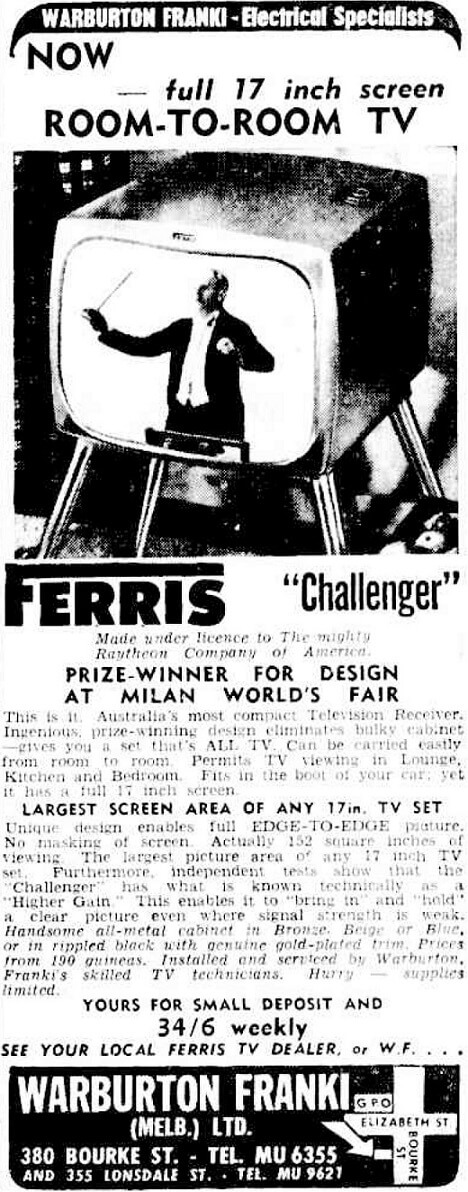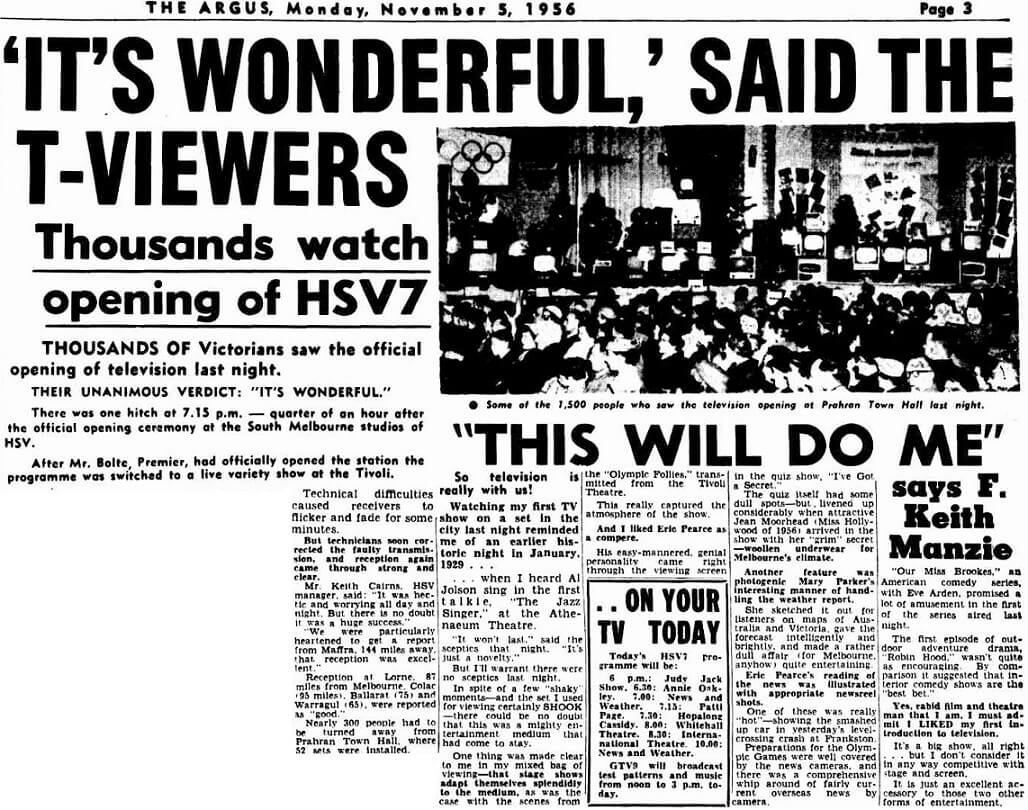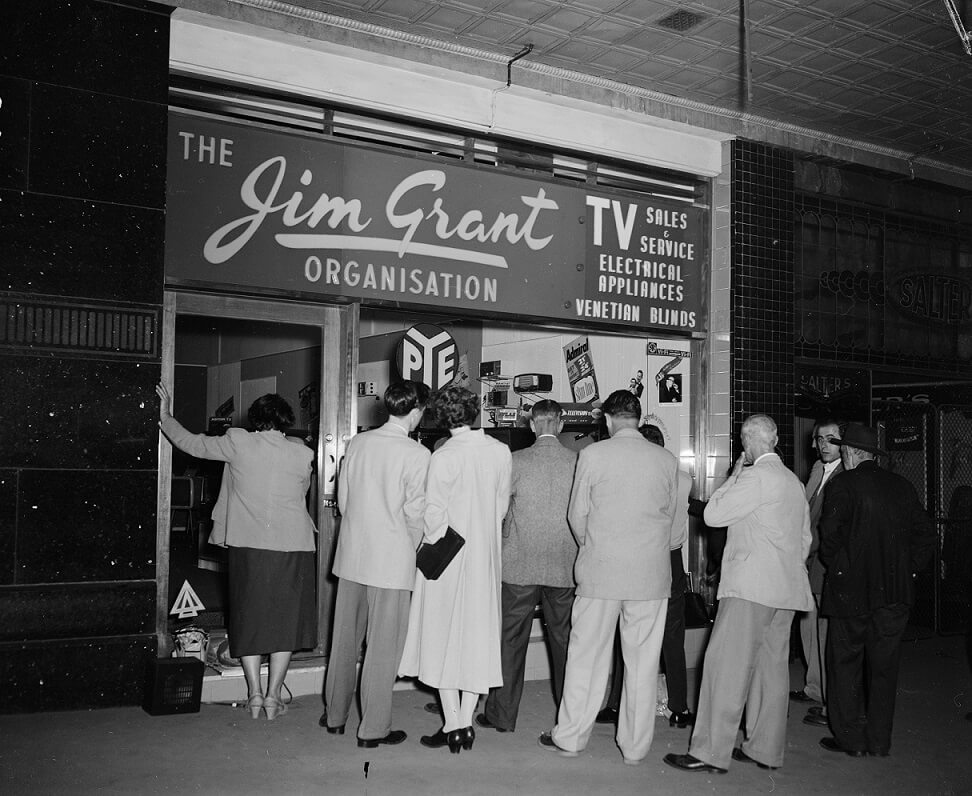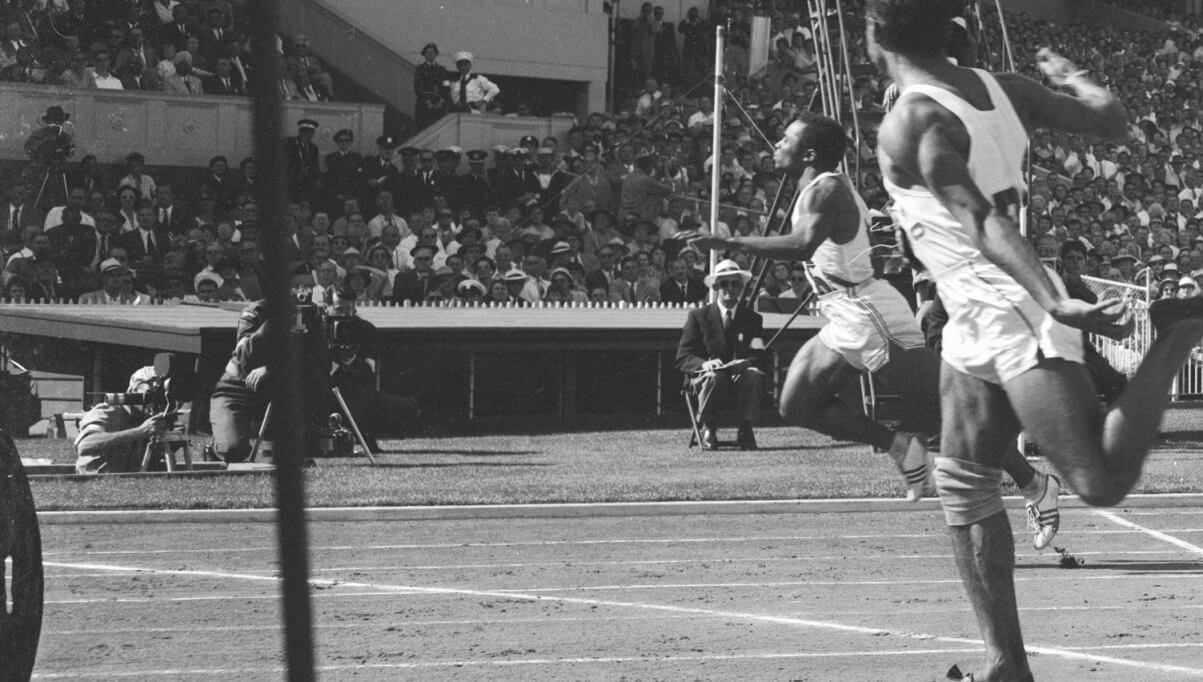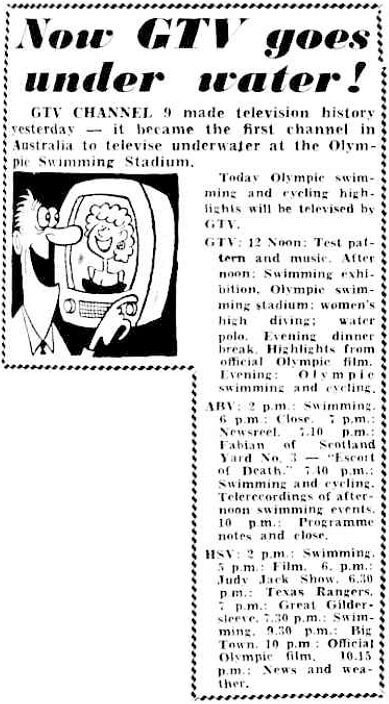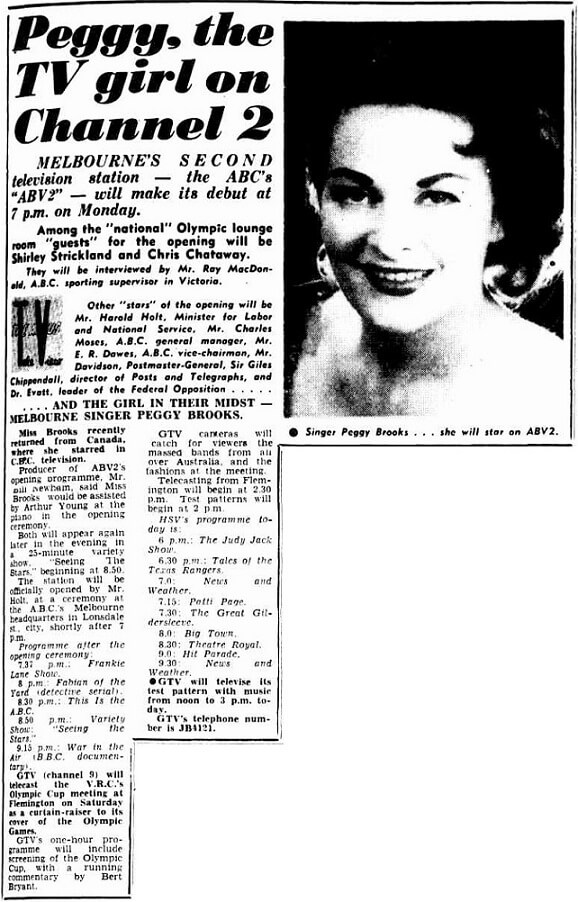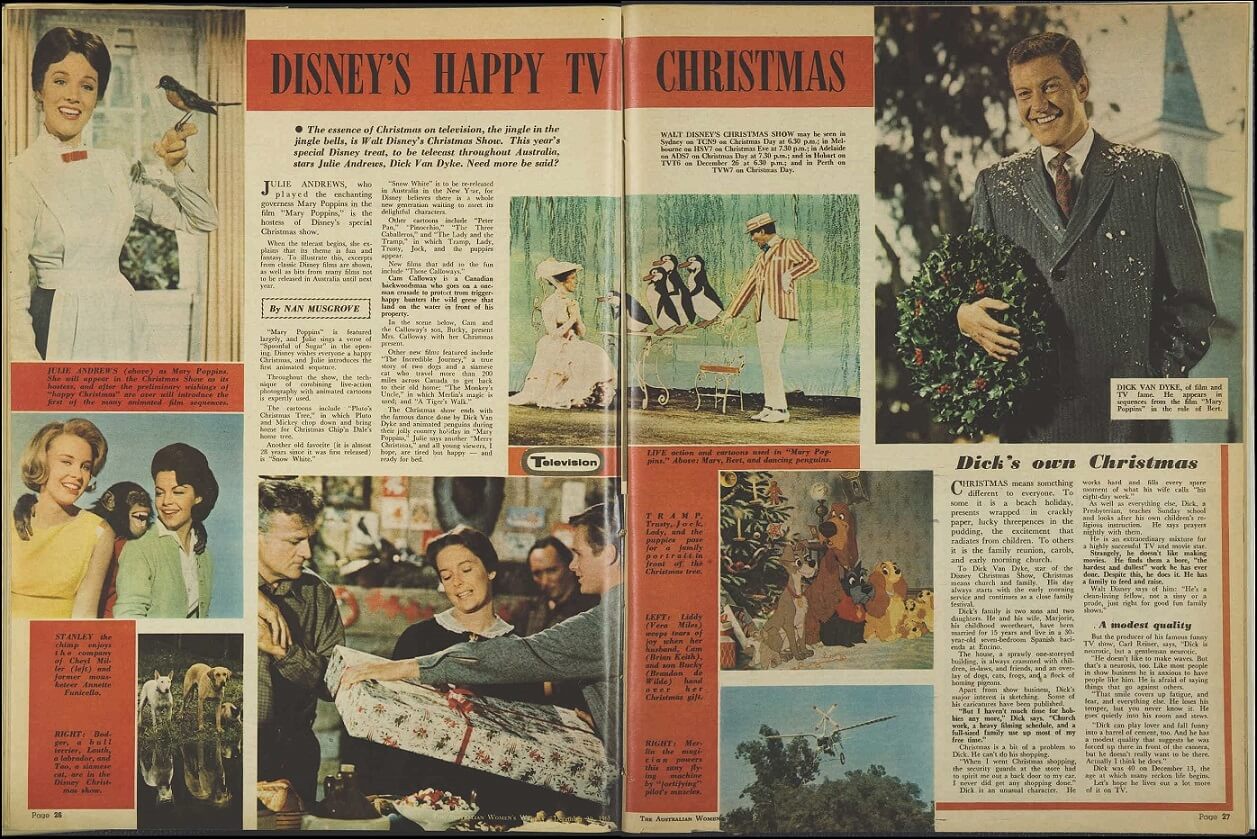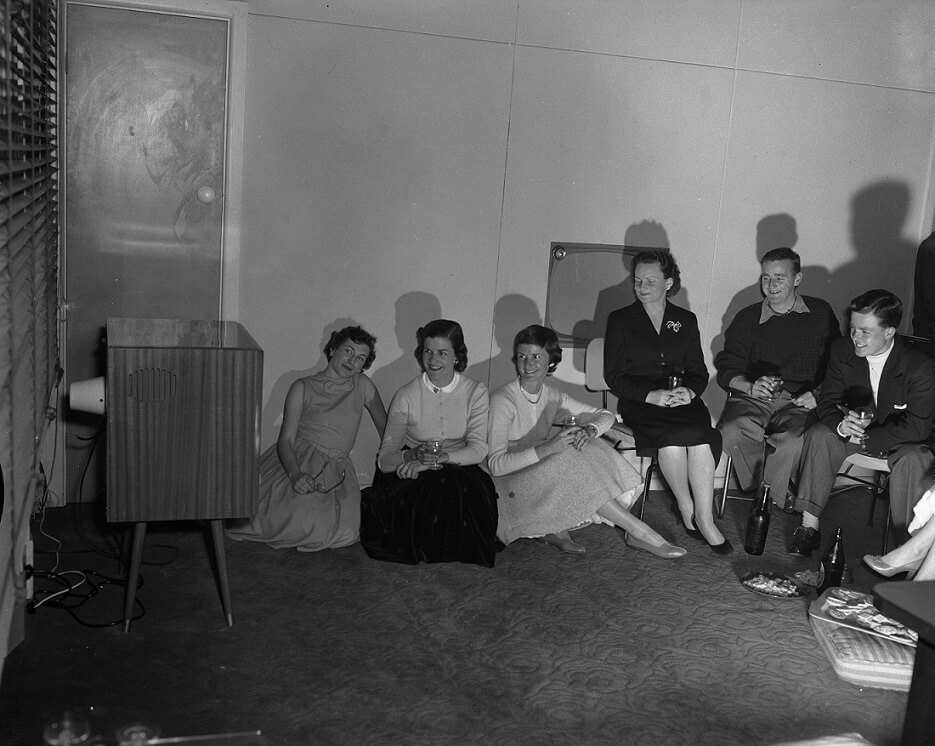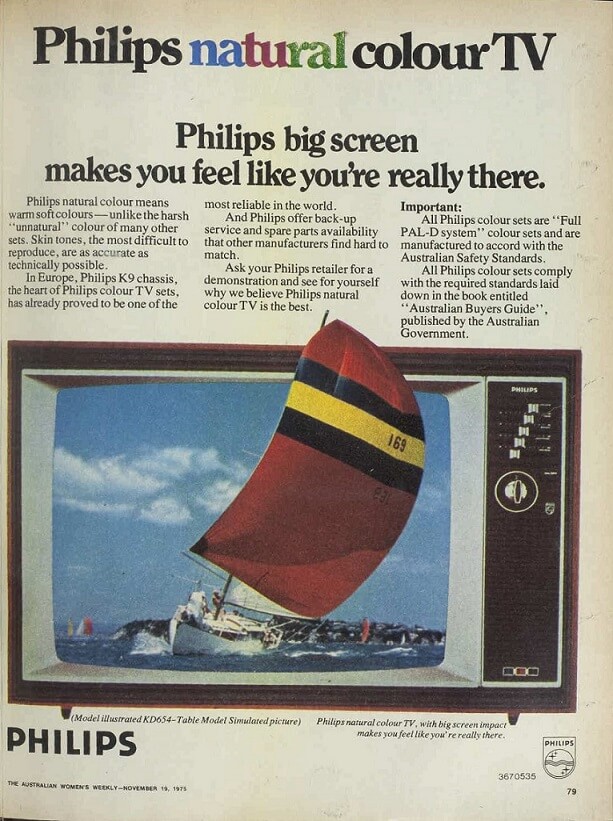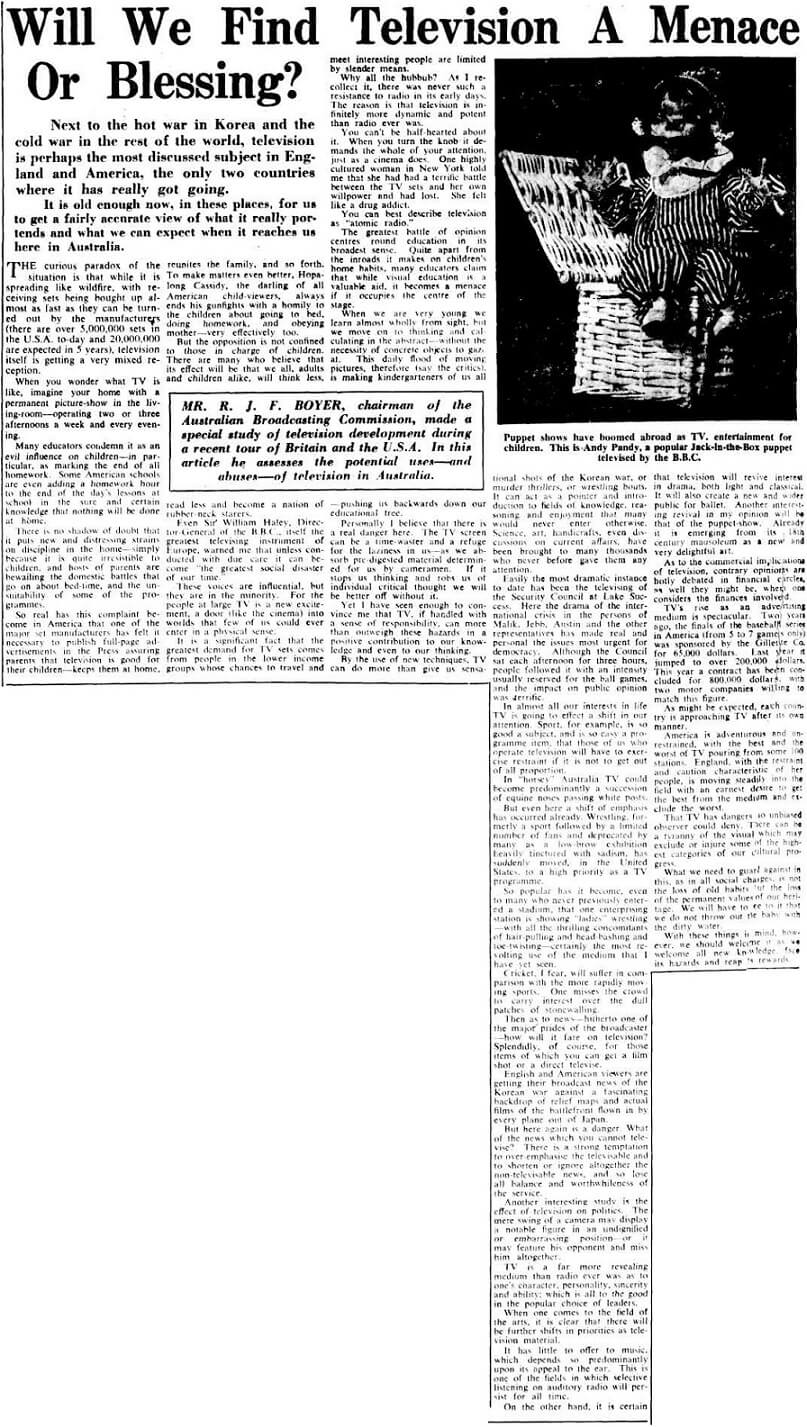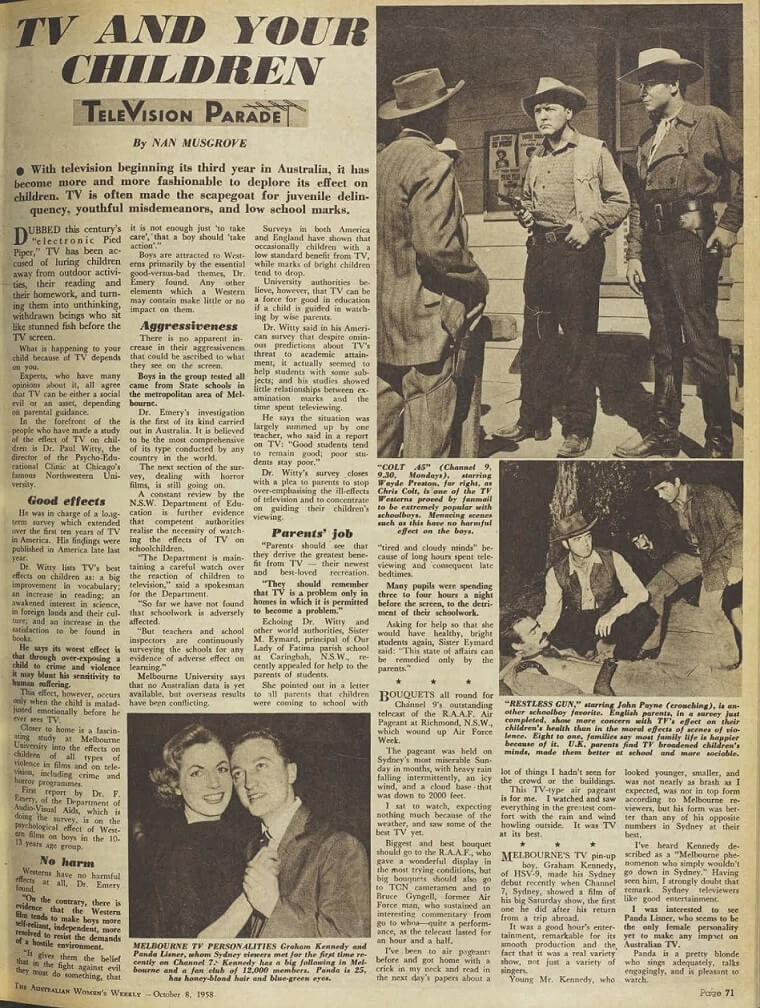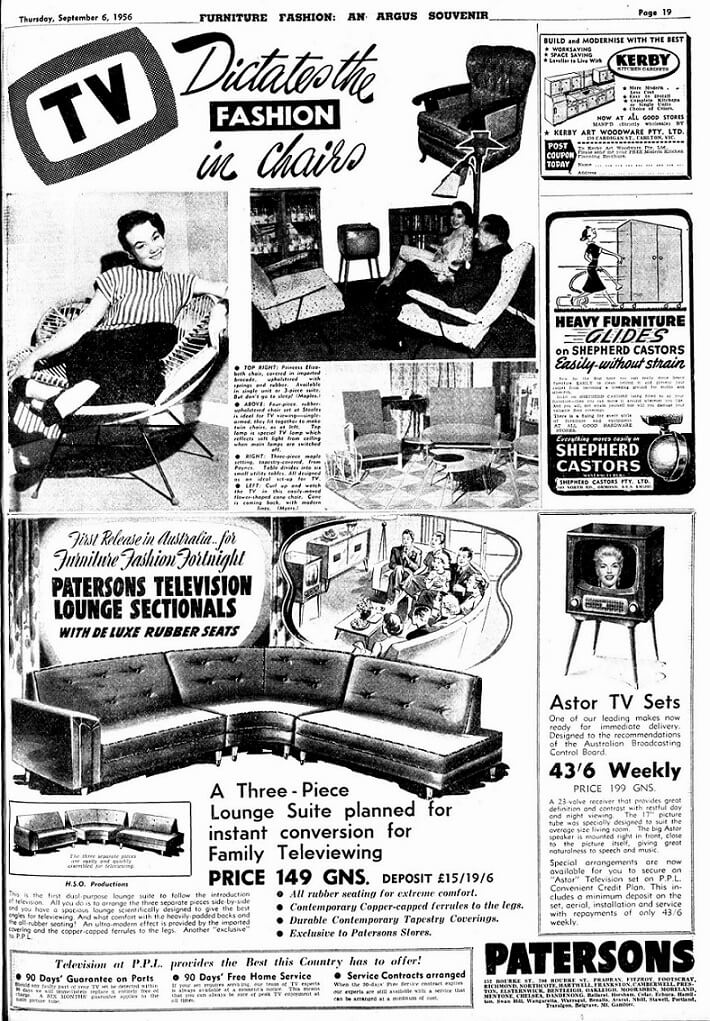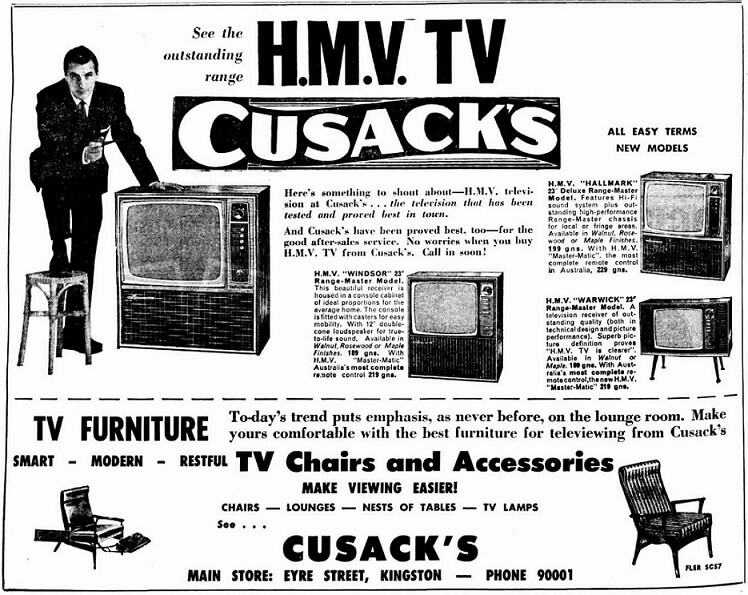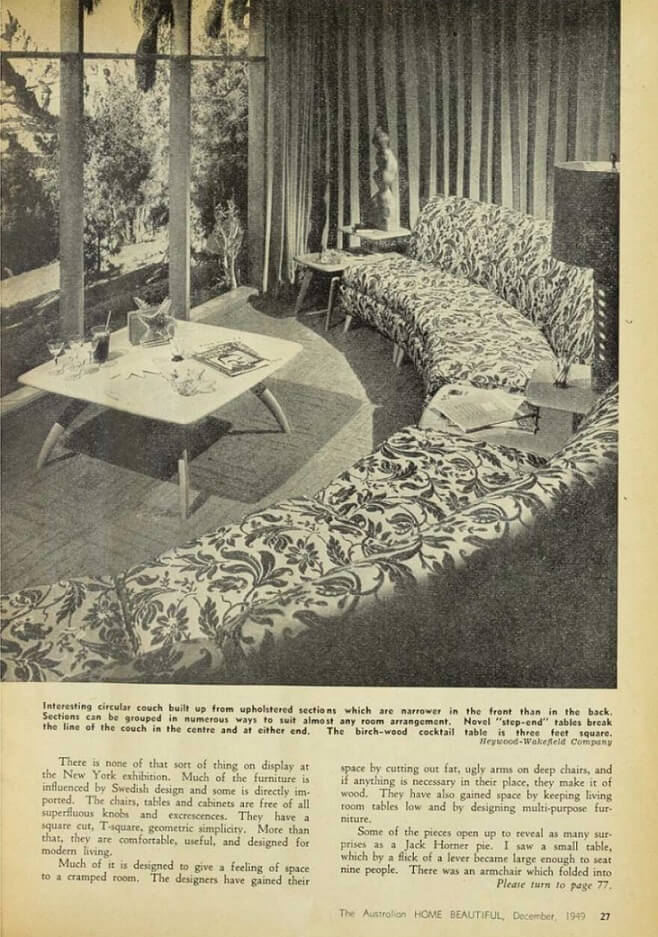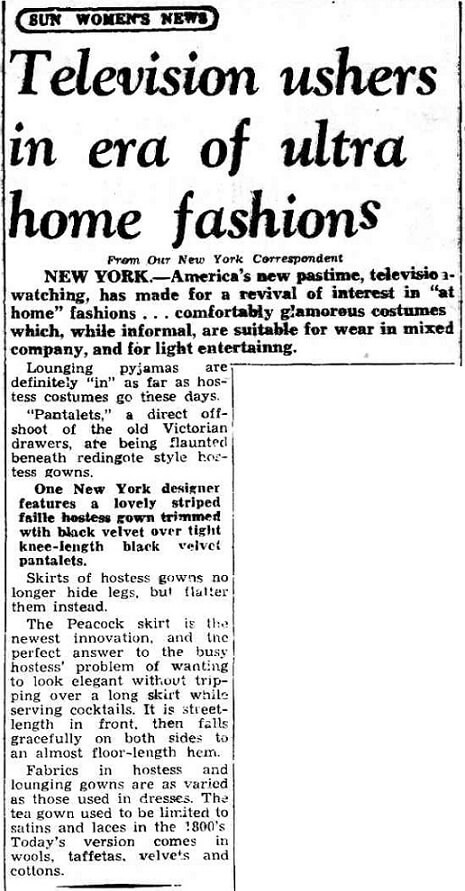After work and sleep, the average Victorian spends more time watching television than any other activity. In fact, Australian adults spend an average of 13 hours each week watching TV. Television is firmly entrenched in our daily rituals of entertainment, relaxation and information. For some, television is still the main source of news and current affairs.
Most of us have grown up with one (or more) television sets in our homes. And today, with streaming services, iPhones and iPads, we can watch what we want, whenever we want, in our home, or on the tram, bus, or train.
Older generations, however, will remember the ‘coming’ of television as a truly momentous event.
Ferris “Challenger” Television, 1956
Mont de Lancey Homestead
On display in Belongings: Objects and Family Life is this Ferris ‘Challenger’ Television, 1956, on loan from Mont de Lancey Homestead.
Promoted as ‘Australia’s most compact Television Receiver’, with ‘edge-to-edge picture’, the TV was purchased at Bennett Bros of Lilydale by the Burgi Family for their grandmother in 1956, just in time for her to watch the Melbourne Olympic Games.
Only about 5,000 homes had television sets in 1956. You can only imagine how many people huddled around this TV to watch.
Advertisement for the Ferris ‘Challenger’, with its ‘ingenious, prize-winning design’ and ‘largest picture area of any 17-inch screen TV set’, available for purchase at Warburton Frank, Bourke and Lonsdale streets, Melbourne, 1956
Television is ‘turned on’
Article from the Argus newspaper the day after TV was launched in Melbourne, 5 November 1956
National Library of Australia
Television began broadcasting in Melbourne at 7pm on Sunday 4 November 1956. It was an exciting event. The lucky few who owned a TV held parties at home. Large crowds huddled outside the windows of electrical shops to watch TV sets in the windows. Nearly 300 people had to be turned away from a packed Prahran Town Hall where a dozen sets had been lined up on the stage.
Melbourne’s first television station was HSV-7, owned by Herald and Weekly Times Ltd, who published Melbourne’s Herald and Sun newspapers. With studios at South Melbourne, the station went to air just 18 days before the Melbourne Olympic Games. The station’s ‘opening ceremony’ included speeches by Australian Prime Minister Robert Menzies and Premier of Victoria, Henry Bolte, and was followed by a live telecast from Melbourne’s Tivoli Theatre.
The Argus reported that ‘in spite of a few shaky moments’ (technical difficulties caused receivers to flicker and fade), there ‘could be no doubt that this was a mighty entertainment medium that had come to stay.’
‘The public was curious, cautiously sceptical, and keenly aware of the high price of a home TV. set — somewhere between £200 and £250’
Central Queensland Herald, 8 November 1956
In 1956 a new 17-inch (43 cm) television set cost over £200, up to 10 times the average weekly wage, and not surprisingly, only about five per cent of Melbourne households owned one. It was common to see crowds of people watching TV through shop windows. Myer advertised in 1956: 'For the inauguration of TV, see our Bourke Street windows! Every night till Christmas, too!'
Households were required to buy a viewer ‘licence’. The licence cost £5, with an added 2 pounds 15 shillings for radio, and was valid for 12 months. Non-payment was a punishable offence with fines of up to 50 pounds. TV licences were abolished in 1974.
The second station in Melbourne was ABV-2. Operated by the Australian Broadcasting Commission (later Corporation), or ABC, and funded by the Federal Government, it went ‘live’ on 19 November 1956. ‘Technically perfect’, the Argus reported:
It was a happy omen… that the first national TV programme to be shown officially in Melbourne was free from mishap, free from interruption, and a credit to the technicians.
Melbourne’s second commercial television station, GTV-9, was launched two months later, on 19 January 1957. Stars of their opening ceremony included Shirley Strickland (winner of three gold medals at the Melbourne Olympics Games) and Melbourne singer, Peggy Brooks.
The Melbourne Olympic Games was the first games to be televised live, although only to a Melbourne audience. (Footage was flown both interstate and overseas and telecast after the event.) All three stations — HSV-7, GTV-9 and ABC — televised the Games.
Finish of 100 metres 1st semi-final won by USA (No. 56); 100m; Athletics; Day 3
Public Record Office Victoria
Australian athletes delivered a stellar performance at the Melbourne Olympic Games, coming third on the medal table. They did particularly well in both swimming, and track and field. Betty Cuthbert, Shirley Strickland, Dawn Fraser and Murray Rose went on to become household names.
GTV-9 made ‘television history’ when it became the first channel to televise underwater at the Olympic Swimming Stadium. The stadium was built specifically for the 1956 Olympics and played host to the diving, water polo, modern pentathlon and swimming. It is the only major structure remaining from the 1956 Olympic Games.
‘A mighty entertainment medium…’ – Argus 5 November 1956
Television rapidly became one of the most popular forms of entertainment, and one of the most influential news media in the country. In 1956 less than five per cent of Melbourne households had a set: just ten years later, this figure was about 90 per cent — remarkable considering the high cost of television sets and the annual licence fee.
By 1957 six stations were broadcasting in Sydney and Melbourne and television services had extended to Hobart, Brisbane, Adelaide and Perth. The first regional TV service in Victoria, Gippsland’s GLV-10, launched in 1961. Some rural areas had to wait years, even decades, to get television.
Most of the content shown on early Australian TVs was American (at least 80 per cent)— a range of sitcoms, westerns, children’s programmes and variety shows:
An example of American content shown on Australian TV in the 1960s, Walt Disney’s Christmas Show, featuring Julie Andrews and Dick Van Dyke, Australian Women’s Weekly, 29 December 1965.
National Library of Australia
Locally-produced programming expanded in the 1960s and 70s. Some Melbourne-made programs included GTV-9’s In Melbourne Tonight — a popular nightly variety show hosted by Australia’s first TV ‘star’, Graham Kennedy — and It Could Be You, another popular (daytime) variety show hosted by American comedian Tommy Hanlon Junior:
With its combination of games, hidden-camera segments and human-interest stories, performed daily in front of a live audience, [It Could Be You] received so many letters from its viewers (18,592 on one day in 1961) that a new Richmond Post Office had to be built to cope with the volume of mail.
Encyclopedia of Melbourne, entry for ‘Television’
HSV-7’s Homicide, a weekly police drama set in Melbourne, began in 1964 and ran for 13 years. Produced by local production company Crawfords, it was the first locally-made program to rate in the national Top 10. Australia’s first successful weekly serial drama (or ‘soap opera’), Bellbird, was made in Melbourne by the ABC at their Ripponlea Studios. It showed four nights a week, from 1967 to 1977, and centred around the residents of a fictional Victorian rural township. It was a huge success, paving the way for later Australian serial dramas such as A Country Practice, Neighbours and Home and Away. The ABC also produced the iconic music program, Countdown, which spanned 13 years from 1974 to 1987, and was hosted by Melbourne identity, Ian ‘Molly’ Meldrum. For a generation of Australian youth Countdown’s weekly hour of music television was ‘essential viewing’. The show was broadcast nationwide each Sunday night at 6pm and offered a mix of in-studio performances, video clips and interviews, closing with the national Top 10 countdown. Countdown introduced local artists — Skyhooks, Marcia Hines, and AC/DC — and attracted a massive youth audience to the ABC.
During these early years, broadcast hours were short. Stations showed programs for a few hours each day and broadcast the ‘test pattern’ for the remaining airtime. Broadcast times gradually increased, although ABC did not commence 24-hour broadcasting until 1993.
Communal television viewing was a popular activity for families and friends throughout the 1950s and 1960s. Older generations may recall watching significant events with neighbours or friends —the assassination of US President John F. Kennedy (1963), for example, the Apollo 11 landing on the moon (1969), or the footage of ousted prime minister, Gough Whitlam, at Parliament House in 1975.
‘Entertainment Unlimited, Astor Precision Radio’, Australian Women’s Weekly, 22 December 1945
National Library of Australia
Cinemas could not compete with TV and the industry suffered a severe decline, before adjusting to the new circumstances. In 1957, cinema attendances declined in Victoria by 5 million visits, and a third of Melbourne’s cinemas had closed by 1959.
Television also heralded a change in the ‘Golden Age’ of radio. Radio’s serial dramas, variety and quiz shows, the mainstay of evening programming, appealed less to listeners who discovered similar formats on television. Reinventing itself, radio became the place for the news 'scoop’ (television news was initially slower to produce), and introduced 'talkback’, with listeners invited to 'phone in’.
‘Philips natural colour TV’, The Australian Women’s Weekly, 19 November 1975
Reproduced courtesy National Library of Australia
Early television was black and white. Colour television was introduced in Australia in 1975 and by 1978, it was in 64 per cent of Melbourne homes — one of the fastest changeovers from black-and-white to colour in the world. It was followed by the video cassette recorder, first commercially released into Australia in 1980. Cable or pay television came to Melbourne in 1995, and digital television followed in 2001.
‘Television: A menace or a blessing?’ – Advertiser, 20 September 1950
Television is going to be one of the big menaces of the future. But in what way? And who is it going to menace? The gleam in your eye gives you away. You think there’s something new about T.V. You think it’s going to give you a new experience; a new savour of life… Instead, take a look at what is already happening in the U.S.A. And remember that much worse is still to come. In New York and other big American cities — there is a more civilised approach in England – people are tearing down book-shelves, bureaus; slinging out cocktail cabinets; generally playing havoc with their domestic ensembles so that a ‘viewing room’ can be created. The effects are more devastating than they may seem. Children are refusing to study or eat because taking meals or studying is a waste of good viewing time. So parents are putting tables with built-in seats in front of the T.V. set so that the youngsters can fill their stomachs and their eyes at the same time. But you won’t see school books on those tables. Some families are going even to the length of screwing down their most comfortable chairs so that they cannot be moved away from the hypnotic screen.
W.A. Clark, Sydney Morning Herald, 13 January 1951
As historian Michelle Arrow points out, television was ‘a novelty, a public spectacle, and viewers responded accordingly’. But there was some apprehension about what television might do to Australian society. Critics warned that television would ‘destroy domestic intimacy’ and impact adults and children alike, making them ‘think less, read less, and become a nation of rubber-neck starers.’ According to the Australian Woman’s Mirror:
In American homes and, according to reports, “looking-in” is finding addicts and is on the way to becoming as habit-forming as any popular dope-craze. One reads of American children neglecting their homework and all other interests to sit and stare at the television screen, of people who, as their homes burn around them, ignore all their other possessions to rescue the television set… of large numbers of the community who have forsaken – think of it! – the movies, far preferring to huddle each night round the television screenlet.
Australian Woman’s Mirror, Vol. 28, No. 3 (12 December 1951)
One concern was the ‘Americanisation’ of Australian culture. With more than 80 percent of television content sourced from the United States, it was feared that American content and themes would impede the development of the Australian identity:
Both the good and bad potentialities of television were shown at the preview last Wednesday at Rose Bay of Australian TV programs. Captain Thunderbolt and some of the educational shorts showed that Australian actors, directors and technicians can compare with the world’s best. But two other short films showed that already some of our Australian technicians are copying the worst American TV technique of giants, skeletons and nerve-wracking advertising slogans. A puppet film about “Terrific the Giant” could hardly have been worse if it had deliberately been designed to frighten children and give them nightmares. It was completely lacking in any Australian atmosphere. It was followed by a short color [sic] film advertising Juicy Fruit chewing gum in which the star item was a skeleton whose head came off every now and again. There was also a cuckoo in this film, and something about ghosts, but please don’t ask me what it was all about. Even a Smoky Dawson film with some good shots of kiddies and koalas was slightly spoilt by Americanisation. Why do Australians have to pretend to be Yankee cowboys? Let’s make it clear from the start that if Associated TV and other firms are going to put on nightmares and freaks and Americanised programs, they wont get the support of the Australian people.
Len Fox, ‘TV, Vast Power for Good or Ill’, Tribune, 28 January 1953
The live shows are interesting and provocative… but they are not as bright and personal as I hope they will be when we stop being imitative. We should strive for a unique Australian style and make no apologies about our ideas. Put them across and let people enjoy them. It is distressing to find our own TV live shows too Americanised. It is more important to have shows that are a little unskilled rather than sacrifice our own national style.
Michael Pate, quoted in The Australian Women’s Weekly, 13 May 1959
There were worries that, unlike radio, television might require the housewife’s complete attention and disrupt her work in the home. In 1950 House Beautiful warned of television:
It delivers about five times as much wallop as radio and requires in return five times as much attention.... It’s impossible to get anything accomplished in the same room while it's on.
Women’s magazines offered advice on incorporating television within the home - ‘get the damn thing out of the living room' – and daily routines. Woman’s Day readers were advised ‘if you can manage yourselves well and manage your family well, you can manage TV well.’ The Australian Women’s Weekly was sterner:
Dubbed this century’s ‘electronic Pied Piper’, TV has been accused of luring children away from outdoor activities, their reading and their homework, and turning them into unthinking, withdrawn beings who sit like stunned fish before the TV screen. What is happening to your child because of TV depends on you. Parents should remember that TV is a problem only in homes in which it is permitted to become a problem’.
Many educators condemn it as an evil influence on children — in particular, as marking the end of all homework. Some American schools are even adding a homework hour to the end of the day’s lesson at school in the sure and certain knowledge that nothing will be done at home.
There is no doubt that it puts new and distressing strains on discipline in the home — simply because it is quite irresistible to children, and hosts of parents are bewailing the domestic battles that go on about bed-time, and the unsuitability of some of the programmes…
You can’t be half-hearted about it. When you turn the knob it demands the whole of your attention, just as a cinema does. One highly cultured woman in New York told me that she had had a terrific battle between the TV sets and her own willpower and had lost. She felt like a drug addict.
TV’s impact on the home
‘Spare a thought for television’ in The Australian Home Beautiful, 29 November 1949
Reproduced courtesy National Library of Australia
Despite the concerns, most Australians loved television and it quickly impacted on home design. Households arranged their living rooms around the demands of watching television. Furniture stores featured new designs — the TV divan, the TV lounge, the TV suite, the TeleVue arm lounge suite, the TV chair, the Tele-chair and the Viewmaster — sofas and chairs specially designed for 'televiewing':
Set low so that viewers' eyes were more-or-less level with the television screen, their comfort allowed users to sit for long periods, while their lightness allowed them to be moved nearer to the set. Offering to solve the problem posed by friends and neighbours dropping by to view the still scarce sets, one local manufacturer boasted: 'No more worrying about how all your guests or all the family can enjoy direct TV viewing, for the Nashline lounge adds longer length to its beautiful new square-line design so that not three but four people may be accommodated in super soft rubber foam all-over comfort'.
Derham Groves, ‘Television’, Encyclopedia of Melbourne
Surveys found that a quarter of households who bought TV sets improved their ‘viewing room’, with more comfortable chairs and small tables for snacks.
Television inspired a range of new products for home use, including TV dinners and trays, stain-resistant vinyl upholstery, and unbreakable plastic crockery. Even women’s fashion was affected:
TV jackets, waist-length fur coats in either mole with fox trim or suede with mole trim with 'sleeves to the elbow to simplify the hostess' duties of serving food during TV shows', were 'specially designed for television viewing' by Furs Renee of Collins Street, Melbourne.
Derham Groves, ‘Television’, Encyclopedia of Melbourne
American dress designers have been busy designing special television clothes – casual, easy-to-wear, suited for sitting about in at home, and for informal TV parties in friends’ homes. Most favoured fabric for these lounging suits is pure silk, for either exotic Oriental tunic pyjamas or ‘round-the-clock’ ‘dusters’, which go easily from dinner table to divan televiewing. Silk shantung harem pants… metallic silk brocade tunic pyjamas are some of the most favored [sic] designs. Quilted silk duster coats that do for the mornings when preparing breakfast, and for evenings when televiewing are extremely popular with ‘young marrieds’.
The Herald, 3 January 1953
‘TV dictates the fashion in chairs’, The Argus, 6 September 1956
National Library of Australia
‘Today’s trend puts emphasis, as never before, on the lounge room. Make yours comfortable with the best furniture for televiewing from Cusack’s’, The Canberra Times, 4 April 1962
National Library of Australia
The Australian home beautiful: a journal for the home builder, Vol 28, No. 12, December 1949
National Library of Australia
This article predates the arrival of television in 1956. It encourages homeowners to ‘rethink’ the layout of their living room and possibly purchase specially-designed furniture:
Television is affecting chair and sofa design. Many of the chairs are now of the swivel variety made of tubular steel. This sounds horrible, but they are really attractive. The seat and backs are well upholstered and you don’t see much chrome. The sofas, often without arms, are semi-circular and designed to separate into individual seats for use after the television party.
The Newcastle Sun, 6 September 1950
National Library of Australia
America’s new pastime, television-watching, has made for a revival of interest in ‘at home’ fashions… comfortably glamorous costumes which, while informal, are suitable for wear in mixed company and for light entertaining.
LOUNGING PYJAMAS are definitely ‘in’ as far as hostess costumes go these days. ‘Pantalets’, a direct off-shoot of the old Victorian drawers, are being flaunted beneath redingote style hostess gowns.
Diversity on our screens
If — like me —you grew up as a non-white kid in Australia, you wouldn’t have seen many people on Australian TV who resembled you. In the 1990s and 2000s, Asian-Australians had Cindy Pan, Elizabeth Chong, Lee Lin Chin and Annette Shun Wah, but scripted roles were pretty rare. Off the top of my head, I can remember one Asian dude on ‘Home and Away’ — let’s call him, oh, I don’t know, Victim of Racism — who disappeared as soon as Alf Stewart learned his lesson that racism was bad. ‘Neighbours’ had the Lim family, a Hong Kong Chinese family who moved onto Ramsay Street and were promptly accused of eating a neighbourhood dog. It was pretty grim.
Benjamin Law, ‘The problem of limited diversity on Aussie TV’
Historically, Australian television was dominated by Anglo-centric stories, faces and voices.
The Special Broadcasting Service (SBS), launched in 1980, plays a significant role in showcasing culturally-diverse programs and actors, but there is still some way to go.
Racialised caricatures and performances were common until (alarmingly) recently. In 2009 the Nine Network's Hey Hey, It's Saturday sparked a worldwide outcry for showing five men in ‘Blackface’ (the practice of white performers using shoe polish or theatrical makeup to imitate the appearance of a black person) performing a Jackson Five song. During his 2011 series ‘Angry Boys’ Australian comedian Chris Lilley donned blackface to play the character of S.mouse, an African-American rapper with songs like “Slap My Elbow” and “Squashed N*gga”. Three years later Lilley played a troubled Tongan boy whilst wearing dark make-up and a curly wig, a performance that the Guardian newspaper described as a ‘modern minstrel show’.
The latest report from Screen Australia (2023) shows increases in the levels of diversity on screen since 2016. Representation of First Nations people has risen from 4.8 per cent to 7.2 per cent (compared to a population benchmark of 3.8 per cent). However, First Nations characters were concentrated in a small number of programs, such as Cleverman, Black Comedy, Mystery Road and Wentworth.
Characters from non-European backgrounds more than doubled, increasing from 6.9 per cent to 16 per cent, but this is well below population benchmarks. Television news and current affairs programs are still overwhelmingly presented by people from an Anglo-Celtic background.
Disabled representation rose from 3.6 per cent to 6.6 per cent, but this is also below levels in the general population. LGBTIQ+ representation rose from 4.5 per cent to 7.4 per cent — again, lower than the estimated 11 per cent of the population who identify as LGBTIQ+.
Memories of television
I don’t remember the first time I watched television, but I do remember key TV ‘moments’.
I remember watching ‘Jaws’ with my (much) older brother. It changed the way I felt about the ocean and open water. I remember watching Stephen King’s ‘It’ and ‘Pet Cemetery’ (again with my brother, can you spot a theme?) I refused to go outside after dark and, for some years, was pretty convinced an old family pet haunted our home. And I still have mixed feelings about clowns, drains and plugholes (IYKYK).
I remember when RAGE began in the late-1980s. As a country kid in rural Victoria this was my window to the outside world (at least of rock and pop music). On Sunday mornings I would sneak into our living room to catch the ‘Top 50’. Oh, how glorious it all was – Madonna, Salt-n-Pepa, Iggy Pop. I’m embarrassed (and a little bit proud) to say that I still know all the words to ‘Like a Prayer’ and could (probably) dance along to ‘Rhythm Nation’.
But it is not so much ‘what’ I watched, but ‘how’, that interests me now. Growing up, we had one television. Most families did. We had no choice what to watch, or when, and I was last in the pecking order — my parents and brother had ‘first dibs’. Even if I was allowed to watch (my parents were quite strict), and got in first, there wasn’t much on. With only four channels (yes, Millennials, four!) it was slim pickings. There wasn’t much else to do but play outside!
My children know of no such deprivation. As I type, my eldest is in the rumpus room watching a movie. My youngest is on the Ipad watching her latest series (age appropriate, I promise), and my husband and I are watching a Scandi crime drama from the couch in our living room. Long gone are the days when you had to choose between ‘Young Talent Time’ or football on Saturday nights!
Internet TV and subscription streaming services have taken over as the leading way people watch. And today, with satellite technology, there are hundreds of channels available from around the globe. There is always something to watch.
We asked staff and volunteers at the Old Treasury Building to contribute memories of their first television. Here are some of them.
MY STORY ABOUT TELEVISION - Louise
I am 70. I grew up in Chadstone, the cultural vacuum of the world in the 1950’s and 60’s. My earliest memories of TV were going to my neighbour’s house on Friday nights to watch Bonanza, followed by a terrible variety show hosted by Bill Collins the name escapes me... I would have been twelve.
I was so envious that my best friend Robyn had TV; we did not get it for another two years and I was overjoyed.
I remember 1969 the year of the Moon Landing. I was at Chadstone High School and sixteen. We were allowed to go home early to watch it on TV. It was an auspicious occasion and TV was a well-entrenched part of my life by then. I do remember a question on the HSC English Expression exam the same year which asked us to evaluate the moral/financial worth of the Moon Landing and I argued strongly in the negative. My opinion has not changed!
I have enjoyed television throughout the decades particularly when I lived in London, with access to the BBC, and still do. I appreciate the free to air, democratic nature of it and the choice it offers particularly with SBS and NITV, illuminating multi-cultural, diverse Australia — a long way from Bonanza!
PICTURE THE SCENE - Jacqueline
Picture the scene. It was June 2nd, 1953, a grey day, overcast and showery. It was unseasonably cold, even for London with the temperature hovering around 12 degrees. In the street where I lived trestle tables had been set up for the children’s party that was to be held to celebrate the coronation of Queen Elizabeth II. We were all very excited as there was sure to be sandwiches and cakes and maybe even sweets as rationing had come to an end earlier in the year. The area had suffered badly during the war and the large hole in the middle of the street was testament to the destructive powers of Hitler’s V2 bombs. The coronation heralded a new Elizabethan age and for the first time it was to be televised. I had never seen a television and no one I knew was in possession of one. However, on that day like millions of other Britons, our next-door neighbour had rented one and we were all invited to come and watch the ceremony. The television was housed in a rather elegant wooden cabinet, but the screen was barely 12 inches across, and intermittently jagged lines obscured the picture and someone had to fiddle with the ‘horizontal hold’. At times the picture disappeared completely so someone had to move around the room waving the aerial until normal service was resumed. There were at least a dozen children sitting cross-legged in front of the screen while the adults crammed into the tiny room cheek by jowl. As the seemingly endless ceremony dragged on, we kids began to wriggle and squabble and one or two of us were given a swift ‘clip around the ear’ and told to shut up. Unlike the adults, who were riveted by the spectacle, all we wanted to do was get out into the street and launch ourselves upon the goodies.
BETTER THAN ELVIS - Marguerite
Our first TV was a 17-inch AWA that cost 200 guineas. I have no idea how much that would be today, but well over $5,000.
It was very exciting watching the test pattern waiting for the first show to come on.
What convinced my father to buy it was the news that one of the channels had bought a batch of old British movies, including some of his favourites.
I became an addict of course and we silly girls at school talked about nothing else much else. Nightly TV even eclipsed Elvis!
TV EVENTS – Alison
My first TV event was the Coronation of Queen Elizabeth II in June 1953. We didn’t have a TV (in Scotland) then — they weren’t yet common and were expensive — but our next-door neighbours, who liked to be ahead of the times, had one and we were invited to watch the event. Being accustomed to Pathé News at the cinema, the black and white imagery was perfectly normal.
In 1957 (exact date uncertain), the BBC TV program Panorama screened a film of actual childbirth, the first time that had been done. I would have been about 11 or 12 years old. I remember my father saying, very casually, ‘Do you want to watch this?’ I certainly did.
About that time, I would have seen my first opera, on TV. From memory, it was Joan Hammond in Madama Butterfly. The singing was great but the closeups required some suspension of disbelief. Hammond was at least mid-40s, not slender and not remotely Japanese looking!
I remember the BBC children’s program Blue Peter better and it was possibly there I first came across a handsome and enthusiastic young man who was familiar with all sorts of interesting animals — David Attenborough.
In late January 1965 (I emigrated to Australia a month later), a major TV event was the funeral of Sir Winston Churchill. Then, as now, state funerals were planned years in advance, documented to the last full stop and carried out strictly according to plan. As with most major UK state events at the time, Richard Dimbleby was narrating. But what wasn’t expected, as the funeral procession made its way down the Thames, was about 36 or more cranes on the river side to slowly lower their jibs down to the waterline, one after another. Nicholas Soames, Churchill’s grandson, said afterwards that this was one action that ‘undid us all’. I think it undid most of the viewers, irrespective of one’s views about Churchill.
I did watch the moon landing on TV – I was teaching at Ascham School in Sydney and took my small, portable TV to school (by bus) so that my students could watch it too.
What TV has recorded has been a welcome (and sometimes unwelcome) reflection of our times. Some notable events have been seen so many times on TV (eg 9/11, the funeral of Diana, Princess of Wales) that the TV images have become our reality. But my personal list of memorable TV moments would include the following:
- News footage of Robert Kennedy’s funeral train and the crowds along the tracks.
- The four-part BBC drama, Talking to A Stranger, with the part of the daughter played by a newish young actress, Judi Dench. George Melly called it ‘the first authentic masterpiece written directly for television’. Dench won the 1967 British Academy Television Award for Best Actress for her performance. The first (and best) Forsyte Saga series was screened (BBC again) about the same time. Both were unmissable.
- News footage of the massacre at My Lai.
- That Was The Week That Was – TW3 (1962/63) was one of the first programs I raced home in time to see. A satirical, irreverent joy. Monty Python came a close second. And no, Mavis Brampton wasn’t within cooee!
- The Challenger launch, when it all went wrong.
- The fall of the Berlin Wall – watched on motel TV in Gippsland!
- News footage (2018) of the killer whale that carried her dead calf across her body for 17 days, refusing to leave it.
- News footage of bodies in bags lined up in New York City during the grim days of COVID.
- The funerals of both Prince Phillip and Queen Elizabeth. It’s doubtful if any royal event will have such a TV (or public) following again as the funeral of the Queen.


